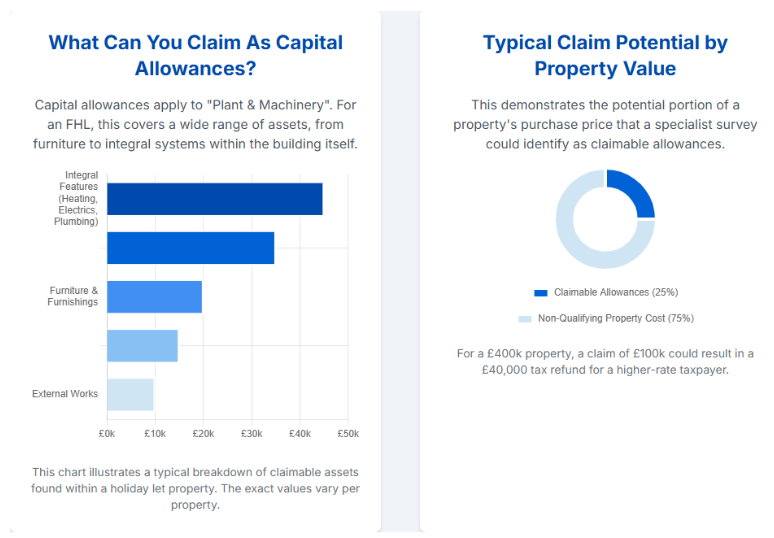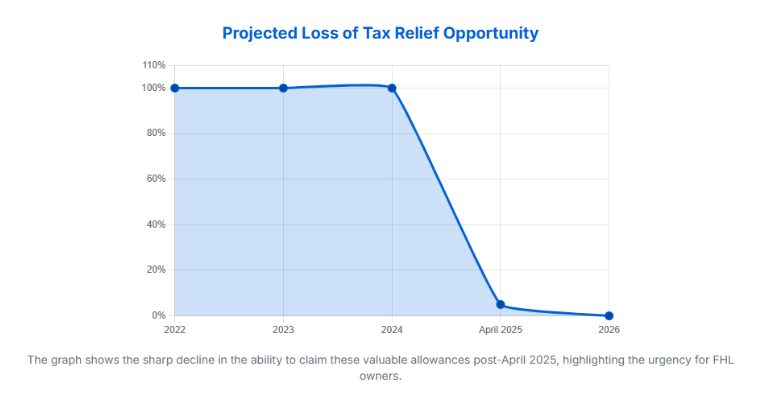Realizing FHL Tax Savings: A Client Case Study
To demonstrate how timely, expert action can unleash significant FHL duty savings. Let’s look at how one customer successfully maximised their FHL capital allowances before the approaching 2025 deadline.
Case Study Mr. a’s Coastal Portfolio Acquisition and Refurbishment
Client Profile and Background
A, a high-rate taxpayer, bought a luxury littoral property in Cornwall for £750,000 in July 2023, intending to run it as a decoration-furnished Furnished Holiday Let. He invested a further £150,000 in refurbishment, including new installations and FHL cabinetwork and outfit allowances. Still, his 2023/24 duty return only covered fluently identifiable loose particulars, missing deeper openings for FHL capital allowances.
The Challenge and Missed occasion
While using the supplements counting base, Mr A had not completely employed the Annual Investment Allowance (AIA) or explored the bedded value of factory and ministry(P&M) within the property’s structure. Without calculating capital allowances on FHL properly, a sizable portion of the implicit furnished vacation let capital allowance relief is overlooked.
Lanop’s Advanced Review (Q4 2024)
Lanop conducted a detailed Capital Allowance Survey, examining literal construction documents, checks, and architectural plans. The analysis uncovered
- Original Bedded Institutions Hidden Qualifying P&M, including electrical and heating systems.
- Refurbishment: Integral Features fresh qualifying particulars, such as upgraded wiring and advanced space and water heating systems.
This forensic review uncovered £145,000 in unclaimed P&M, around 16 of the property’s total investment cost.
The Maximisation Strategy (2024/25)
To optimise duty relief before the 2025 arrestment
- AIA Utilisation £100,000 of qualifying P&M was allocated to the AIA, giving an immediate 100 deduction.
- WDA Pool Establishment The remaining £45,000 in integral features was added to a Writing Down Allowance (WDA) pool, allowing continued deductions post-abolition.
Result and Conclusion
Through visionary planning, Mr A secured over £100,000 in immediate deductions and shielded long-term relief for the remaining balance. Acting before April 2025 assured he maximised his FHL investment duty relief, avoided endless loss of unclaimed value, and significantly reduced his taxable gains. To explore how visionary fiscal structuring can safeguard your means and ensure intergenerational benefits, visit our Heritage Tax Planning section for integrated strategies aligned with your FHL property duty deductions UK pretensions.
How Lanop Helps Regarding FHL Capital Allowances and Tax Optimisation
The specialised complexity of FHL capital allowance claims, combined with the strict 2025 deadline and implicit HMRC scrutiny, requires specialist knowledge. Lanop’s platoon brings expansive experience in specialist property duty and commercial strategy, ensuring every customer’s position is optimised for compliance and maximum return.
Client Quote:
“Lanop helped us make sense of the tax rules around our holiday. They showed us what we could claim and how to do it properly, which saved us far more than we expected. Their guidance made the whole process clear and gave us confidence that everything was done right.”
Precision in Pre-2025 Claim Submission
Lanop ensures all Claim FHL capital allowances are submitted directly and within the needed time limit. This includes vindicating that each FHL operates under the correct supplements counting base, using HMRC-biddable forms like SA105 (individualities) or CT600 (companies). Our detailed analysis guarantees that all FHL capital allowances for HMRC sessions are completely biddable, defensible, and strategically structured.
Specialist Capital Allowance Checks
The loftiest implicit FHL duty savings frequently come from relating bedded integral features missed by general accountants. Lanop’s platoon conducts professional Capital Allowance Checks, uncovering 20–30 retired qualifying factory and ministry (P&M) within property accession, refurbishment, and construction costs. This process maximises FHL property duty deductions UK before the 2025 deadline.
Transitional Planning and Checkups
Lanop provides visionary guidance to ensure flawless compliance during the FHL capital allowances changes period, including
- WDA Pool Management: Establishing and maintaining unrelieved pools as of April 2025 to save long-term relief.
- Commercial Optimisation icing limited companies use Full Expensing and AIA before the 1 April 2025 cut-off.
- Post-Abolition Compliance Supporting guests in transitioning to the relief of Domestic particulars Relief (RDIR) for post-2025 expenditure.
Holistic Duty Advice
Lanop’s support extends beyond capital allowances. We give full-diapason advisory on affiliated counteraccusations, like the pullout of Capital Earnings duty (CGT) reliefs like BADR, and the mortgage interest deduction cap. Our integrated approach ensures guests maintain duty-effective vacation let investments, combining moxie across Landlord Services, Limited Companies, and Tax Planning for complete fiscal alignment.










